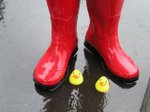 The Myths series has a bit of the gimmick about it. These "contemporary take[s] on our most enduring myths", with their promises to "shed new light". The books so lovely and slim, they could almost slip inside a pocket, so there is certainly no physical evidence of their substance. Look at the drawing on the cover of Girl Meets Boy, for example, all delicate lines and flowers. Positively precious.
The Myths series has a bit of the gimmick about it. These "contemporary take[s] on our most enduring myths", with their promises to "shed new light". The books so lovely and slim, they could almost slip inside a pocket, so there is certainly no physical evidence of their substance. Look at the drawing on the cover of Girl Meets Boy, for example, all delicate lines and flowers. Positively precious.But what would you say if I told you the drawing was called "Self Portrait as a Small Bird" and the self being portraited was Tracey Emin. Wouldn't you agree then, that this is a book with tricks up its proverbial sleeve? And so it is, being a book by Ali Smith, whose The Accidental was one trick after another. But now the trick is on me, and it may be on you, because there's nothing of the gimmick about Smith's latest novel at all.
"Smith's latest novel" I say, for this is exactly right. It is a powerful novel and it can stand alone. A slim book, yes, and part of a series, but then there is actually very little uniform about The Myths. Featuring a wide range of writers from various backgrounds who select their own myths and approach these stories in any way they choose. In Girl Meets Boy, Smith working with the myth of Iphis, from Ovid's Metamorpheses. As she writes in her afterward, "It is one of the cheeriest metamorpheses in the whole, one of the most happily resolved of its stories about the desire for and the ramifications of change."
And like any novel, this one has its very own story. Beginning, "Let me tell you about when I was a girl, our grandfather says." Quickly establishing a world of unfixed parametres, of shape-shifting, as young sisters Anthea and Imogen absorb their grandfather's stories. TV game show Blind Date playing in the background, with host Cilla Black between the panel of boys and the panel of girls. Anthea wondering, "But which is Cilla Black, then, boy or girl? She doesn't seem to be either... She can go between the two sides of things like a magician or a joke."
In the future, however, which is the present day, all the magic has been put aside. The girls' grandparents have long ago been lost at sea, and life is weighty with its disappointments. Anthea has come back home to Inverness to live with her sister, who has been able to secure her a job as a "Creative" for the multinational conglomerate Pure. And Anthea finds herself easily distracted one day during a "Creative" brainstorm session by one certain vandal in a kilt.
In Girl Meets Boy, Ali Smith presents metamorphosis as possibility. Anthea joining forces with the vandal, spreading slogans: "ALL ACROSS THE WORLD, WHERE WOMEN ARE DOING EXACTLY THE SAME WORK AS MEN, THEY'RE BEING PAID BETWEEN THIRTY TO FORTY PERCENT LESS. THAT'S NOT FAIR. THIS MUST CHANGE." Anthea also falling in love for the first time in her life, with this vandal, who is a woman. Much to her sister's horror ("My sister would be banned in schools if she was a book.")
So here is an old story inside inside this new story, which is a love story, and actually no less than two. For such a slim book, this is something, and that the stories sit comfortably amidst so much stuff of ages-- from the ancient Greeks to our poppest of culture, allusions, winks, nods and odes. There are lines and lines and lines between these lines.
But Smith's language, of course, is always her most marvelous trick. Amidst all the stuff, rendering her thesis quite simple: that in a world where things are changeable, things can change. Innumerable doors swinging open upon this promise, that progress is a way forward after all. "And it was always the stories that needed the telling that gave us the rope we could cross any river with." A most refreshing triumph.

